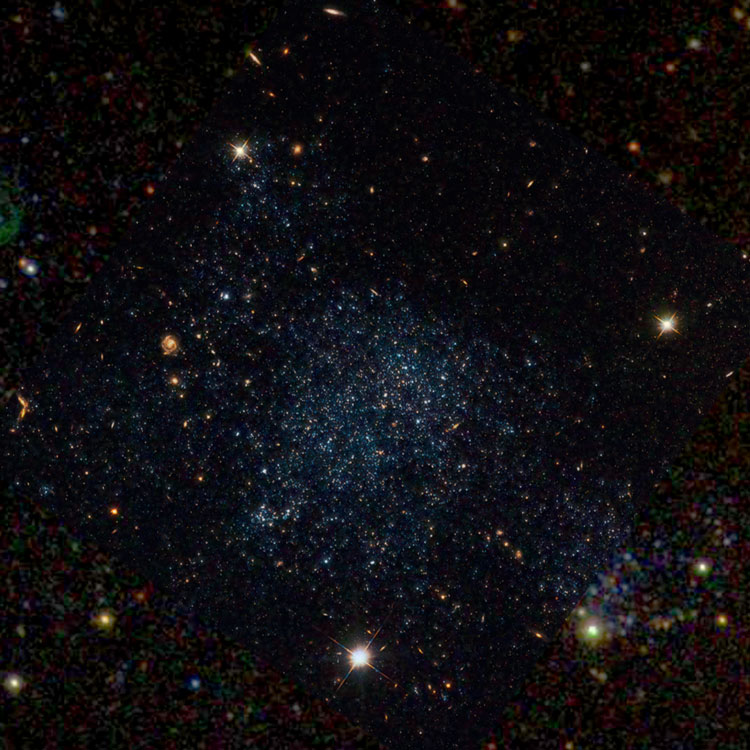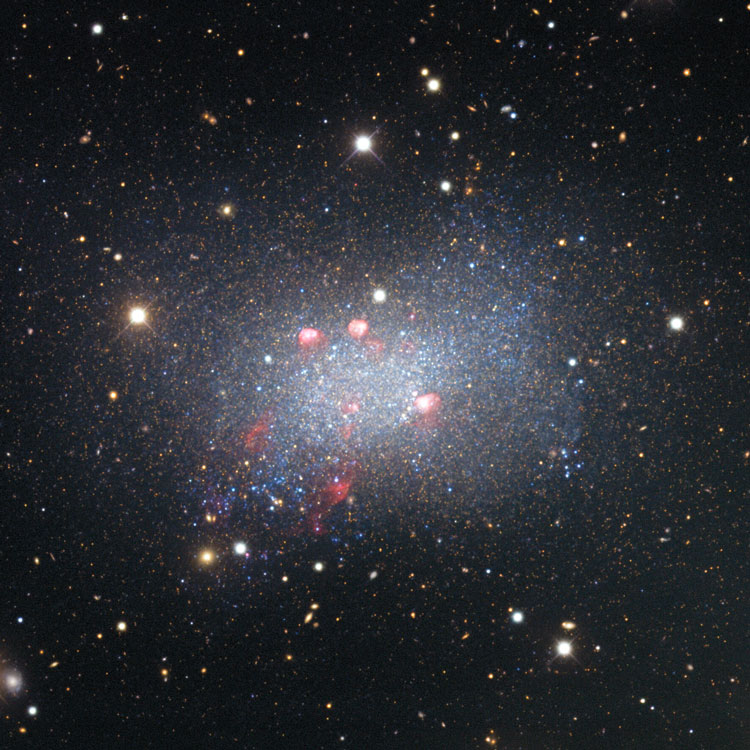Page last updated Mar 3, 2024
Adding PGC entries for IC 573+ objects/companions with PGC numbers on this page
PGC 28513 (= part of IC 573 = same part of NGC 3058)
A magnitude 13.5 spiral galaxy (type Sc? pec) in Hydra at RA 09 53 36.2, Dec -12 28 56
For anything else see IC 573 and/or NGC 3058
PGC 28567
A magnitude 16.0(?) irregular galaxy (type IBm?) in Sextans (RA 09 54 31.0, Dec -06 52 09)
For anything else see here
PGC 28569 (= IC 574)
A magnitude 13.7 lenticular galaxy (type E/SA0?) in Sextans (RA 09 54 27.0, Dec -06 57 12)
For anything else see IC 574
PGC 28575 (= IC 575 = Arp 292)
A magnitude 13.2 spiral galaxy (type Sa? pec) in Sextans (RA 09 54 32.9, Dec -06 51 27)
For anything else see IC 575 and/or Arp 292
PGC 28586
A magnitude 14.5(?) spiral galaxy (type S(rs?)dm?) in Sextans (RA 09 54 47.6, Dec -06 47 35)
For anything else see here
PGC 28603 (= IC 576)
A magnitude 14.3 spiral galaxy (type S(rs)ab?) in Leo (RA 09 55 07.01, Dec +11 02 22)
For anything else see IC 576
PGC 28630 (= NGC 3031 = M81)
A magnitude 6.9 spiral galaxy (type SA(s)ab?) in Ursa Major (RA 09 55 33.2, Dec +69 03 55)
For anything else see NGC 3031
PGC 28636 (= NGC 3027)
A magnitude 11.8 spiral galaxy (type SB(s)bc? pec?) in Ursa Major (RA 09 55 40.6, Dec +72 12 13)
For anything else see NGC 3027
PGC 28662 (= IC 577)
A magnitude 14.0 spiral galaxy (type Sbc?) in Leo (RA 09 56 04.0, Dec +10 29 56)
For anything else see IC 577
PGC 28674 (= IC 578)
A magnitude 13.9 spiral galaxy (type SBb?) in Leo (RA 09 56 16.1, Dec +10 29 10)
For anything else see IC 578
PGC 28702 (often misidentified as IC 579)
A magnitude 13.9 spiral galaxy (type SB(rs)ab?) in Hydra (RA 09 56 39.4, Dec -13 46 31)
For anything else see this entry and/or the entry for IC 579
PGC 28757 (= Holmberg IX, a companion of M81)
A magnitude 14.3 irregular galaxy (type Im?) in Ursa Major (RA 09 57 32.0, Dec +69 02 46)
Physical Information: The recessional velocity of PGC 28757 is only 45 km/sec, far too small in comparison to peculiar (non-Hubble expansion) velocities to be of any use in determining its distance. Redshift-independent distance estimates range from 8.5 to 32.5 million light years, with the most commonly accepted value being 11 to 12 million light years, as it is believed to be a satellite of approximately 12 million light year distant NGC 3031 (= M81). Given that and its apparent size of ? arcmin, the galaxy is about ? thousand light years across. It is believed that most of the stars in the dwarf galaxy (and the galaxy itself) were created as a result of a close encounter between M81, M82 and NGC 3077 between 200 and 300 million years ago. That interaction tore some one of the older stars from one or more of the galaxies and triggered a wave of intense star formation that resulted in most of the stars now visible in PGC 28757, and is still continuing in the region between it and M81 at a slower rate, as evidenced by a "bluish fuzz" in the region near the two galaxies, which consists of newly formed stars, but too few of them to be easily imaged.

Above, a 12 arcmin wide SDSS image centered on PGC 28757, also showing part of M81
Below, a 4 arcmin wide image of the galaxy (Image Credit NASA, ESA, Hubble Heritage Team (STScI/AURA)
Acknowledgment D. de Mello (Catholic University of America & GSFC), superimposed on DSS image to fill in missing areas)

PGC 28788 (= IC 580 = NGC 3069)
A magnitude 14.2 spiral galaxy (type Sa?) in Leo (RA 09 57 56.7, Dec +10 25 57)
For anything else see IC 580 and/or NGC 3069
PGC 28800 (= IC 581)
A magnitude 14.1 spiral galaxy (type (R')SA(rs)b? pec) in Leo (RA 09 58 11.6, Dec +15 56 49)
For anything else see IC 581
PGC 28838 (= IC 582)
A magnitude 14.0 spiral galaxy (type SAB(rs)c?) in Leo (RA 09 59 00.2, Dec +17 49 02)
For anything else see IC 582
PGC 28839 (= IC 584)
A magnitude 14.6 spiral galaxy (type Sc?) in Leo (RA 09 59 05.1, Dec +10 21 40)
For anything else see IC 584
PGC 28844 (= IC 583)
A magnitude 14.5 spiral galaxy (type Sbc?) in Leo (RA 09 59 05.1, Dec +17 49 18)
For anything else see IC 583
PGC 28897 (= IC 585)
A magnitude 13.4 lenticular galaxy (type E/S0?) in Leo (RA 09 59 44.1, Dec +12 59 19)
For anything else see IC 585
PGC 28906 (= IC 586)
A magnitude 13.5 lenticular galaxy (type E/S0?) in Sextans (RA 09 59 50.3, Dec -06 55 22)
For anything else see IC 586
PGC 28913 (= Sextans B)
(= UGC 5373 = CGCG 036-012 = MCG +01-26-005)
A magnitude 11.5 irregular galaxy (type IB(s)m?) in Sextans (RA 10 00 00.0, Dec +05 19 56)
Physical Information: Sextans B is a dwarf irregular galaxy, located on the outer fringe of the Local Group of galaxies, which means it may be a part of the Local Group, or merely a "field" galaxy that just happens to be near us. It has a mass of about 200 million Solar masses, most of which (as in the case of most galaxies) is in the form of "dark matter". Despite its small size, it has several large regions of rapid star formation, and several planetary nebulae, which are the gaseous envelopes ejected by old, dying stars (it is one of the smallest galaxies known to have several planetary nebulae).
One interesting difference between irregular galaxies such as Sextans B and spiral galaxies such as our own is that in irregular galaxies, very little of the gas and dust originally present has been turned into stars, so that massive clusters of stars (such as globular clusters) can still form; whereas in our own galaxy, most of the gas and dust has been turned into stars, and only smaller clusters of stars are now forming. As a result, in our galaxy, globular clusters (large, globe-shaped clusters containing tens of thousand to several million stars) are typically about 12 billion years old; while in Sextans B, a dwarf globular cluster has been found to be only about 2 billion years old.
Based on a recessional velocity relative to the Cosmic Microwave Background radiation of 645 km/sec (and H0 = 70 km/sec/Mpc), Sextans B is about 30 million light years away, in poor agreement with redshift-independent distance estimates of about 4 to 7 million light years, with a median estimate of about 4.5 to 4.9 million light years (the reason for the poor agreement is that for close galaxies, "peculiar velocities" (random motions relative to their neighbors) can make the "Hubble Flow" distance estimate completely useless, as in this case). Using an estimated distance of about 4.7 million light years and its apparent size of about 6.5 by 4.9 arcmin (from the images below), Sextans B is about 9 thousand light years across, making it truly a "dwarf" galaxy.

Above, a 12 arcmin wide SDSS image centered on Sextans B (considerably enhanced)
Below, an 8 arcmin wide image of the galaxy, emphasizing emission by excited hydrogen gas
(Image Credit KPNO/NOIRLab/NSF/AURA; see the linked page for more detailed credits)

*HST image (galaxies/sextansb.jpg) also available, but need to find source to use)
PGC 28960 (= NGC 3100 = NGC 3103)
A magnitude 11.1 lenticular galaxy (type SAB0(s)a? pec) in Antlia (RA 10 00 40.8, Dec -31 39 52)
For anything else see NGC 3100
|